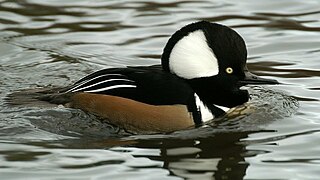
The hooded merganser is a species of small duck. It is the only extant species in the genus Lophodytes. The genus name derives from the Greek language: lophos meaning 'crest', and dutes meaning diver. The bird is striking in appearance; both sexes have crests that they can raise or lower, and the breeding plumage of the male is handsomely patterned and coloured. The hooded merganser has a sawbill but is not classified as a typical merganser.

The village weaver , also known as the spotted-backed weaver or black-headed weaver, is a species of bird in the family Ploceidae found in much of sub-Saharan Africa. It has also been introduced to Hispaniola, Mauritius and Réunion.

The Encyclopedia of Life (EOL) is a free, online collaborative encyclopedia intended to document all of the 1.9 million living species known to science. It is compiled from existing databases and from contributions by experts and non-experts throughout the world. It aims to build one "infinitely expandable" page for each species, including video, sound, images, graphics, as well as text. In addition, the Encyclopedia incorporates content from the Biodiversity Heritage Library, which digitizes millions of pages of printed literature from the world's major natural history libraries. The project was initially backed by a US$50 million funding commitment, led by the MacArthur Foundation and the Sloan Foundation, who provided US$20 million and US$5 million, respectively. The additional US$25 million came from five cornerstone institutions—the Field Museum, Harvard University, the Marine Biological Laboratory, the Missouri Botanical Garden, and the Smithsonian Institution. The project was initially led by Jim Edwards and the development team by David Patterson. Today, participating institutions and individual donors continue to support EOL through financial contributions.

The mountain tailorbird is a songbird species formerly placed in the "Old World warbler" assemblage, but is now placed in the genus Phyllergates of the family Cettiidae.

The hooded dotterel or hooded plover is a species of bird in the family Charadriidae. It is endemic to southern Australia and Tasmania where it inhabits ocean beaches and subcoastal lagoons. There are two recognised subspecies, both of which are classified as endangered.

The red pileated finch, also known as the red-crested finch, is a species of bird in the family Thraupidae. It is found in Argentina, Bolivia, Brazil, Ecuador, French Guiana, Guyana, Paraguay, Peru, on the eastern side of the Andes. Its natural habitats are subtropical or tropical dry forests, subtropical or tropical moist lowland forests, subtropical or tropical dry shrubland, and heavily degraded former forest. This is a common species, and the International Union for Conservation of Nature has rated its conservation status as "least concern".
Macroprotodon cucullatus, commonly known as the false smooth snake, is a species of mildly venomous colubrid snake endemic to the Mediterranean Basin.

Mimetes cucullatus is an evergreen shrub with several, mostly not branching, upright stems of 1–2 m high, that has been assigned to the Proteaceae family. It is the most wide-spread and most common pagoda species that can cope with a relatively large range of environmental circumstances. It is known under several names including common pagoda in English and rooistompie in Afrikaans.

The hooded chameleon, Calumma cucullatum, is a Vulnerable species of chameleon endemic to north-east Madagascar; its geological type locality is Madagascar. It can be found in humid forests over an area of 17,432 km2 (6,731 sq mi) between 400 and 720 m above mean sea level.
Peripsocus is a genus of stout barklice in the family Peripsocidae. There are more than 250 described species in Peripsocus.

Paratettix is a genus of ground-hoppers or pygmy grasshoppers, with more than 60 described species found worldwide.

Tetriginae is a large subfamily of groundhoppers or pygmy grasshoppers. Members of Tetriginae occur on every continent except Antarctica.
Paratettix toltecus, known generally as the toltec pygmy grasshopper or toltecan grouse locust, is a species of pygmy grasshopper in the family Tetrigidae. It is found in Central America, North America, and South America.
Stylurus spiniceps, the arrow clubtail, is a species of clubtail in the dragonfly family Gomphidae. It is found in North America.

Paratettix mexicanus, the Mexican pygmy grasshopper, is a species of pygmy grasshopper in the family Tetrigidae. It is found in Central America and North America.

Paratettix aztecus, the Aztec pygmy grasshopper, is a species of pygmy grasshopper in the family Tetrigidae. It is found in Central America and North America.
Paratettix rugosus, known generally as the rough-back pygmy grasshopper or rough-backed grouse locust, is a species of pygmy grasshopper in the family Tetrigidae. It is found in North America.
Paratettix brevipennis, the short-winged pygmy grasshopper, is a species of pygmy grasshopper in the family Tetrigidae. It is found in North America.
Paratettix curtipennis is a species of groundhopper which belongs to the subfamily Tetriginae and tribe Tetrigini. Its distribution includes: India, southern China, including Tawan, Indo-China and peninsular Malaysia; no subspecies are listed in the Catalogue of Life or the Orthoptera Species File.

Paratettix meridionalis is the type species of ground-hopper in its genus, which belongs to the subfamily Tetriginae and tribe Tetrigini. Its distribution includes: southern Europe, northern Africa, Arabian peninsula and records from Mexico and no subspecies are listed in the Catalogue of Life or the Orthoptera Species File.













